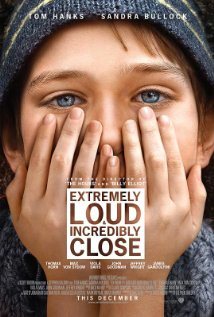 I finally got around to watching the film Extremely Loud & Incredibly Close (2012), based on Jonathan Safran Foer’s novel of the same title. Our book group read the novel several years ago and loved it, so I’ve been looking forward to seeing the film adaptation.
I finally got around to watching the film Extremely Loud & Incredibly Close (2012), based on Jonathan Safran Foer’s novel of the same title. Our book group read the novel several years ago and loved it, so I’ve been looking forward to seeing the film adaptation.
The story involves 10-year-old Oskar Schell, whose father died a year earlier in the September 11 attacks on the World Trade Center. The precocious Oskar finds an envelope, labeled “black,” containing a strange key among his father’s things. Oskar decides that black must be a name, so he sets off to interview everyone named Black who lives in the five burroughs of New York City to find the lock that the mysterious key will open.
I have to admit that my memory of the details of the novel is sketchy. But one aspect of the film that I don’t remember specifically from the book is the emphasis on storytelling. Oskar’s grandmother, who lives in an apartment building across the street from Oskar’s building, has rented out a room in her apartment to an old man. When Oskar finally meets The Renter, played by Max von Sydow, he finds that the old man does not speak. The Renter carries a small notebook and pen with him and communicates only by writing short notes on the little pages—except for the words yes and no, one of which is written on the palm of each hand.
When Oskar realizes that he’s not going to get the man to break his silence, he asks, “Then how will you tell me your story?” The old man shrugs, and Oskar continues, “Then I’ll just have to tell you my story.” He then pours out the story—frantically, non-stop, and with great agitation—of his search to find the lock that the fits the key that his father left behind. But what he’s really pouring out is all the grief, fear, anger, and guilt he’s been trying to deal with since his father’s death.
As Oskar visits each person or family named Black, he takes photos and pastes them all in a scrapbook. And he remembers the details of each person’s life story. At the end of the film he writes a letter to everyone he has visited that includes references to those personal details.
And finally, it seems, Oskar’s experiences on his quest to find the lock that fits the key become the key for a fitting ending to this chapter of his own story.
